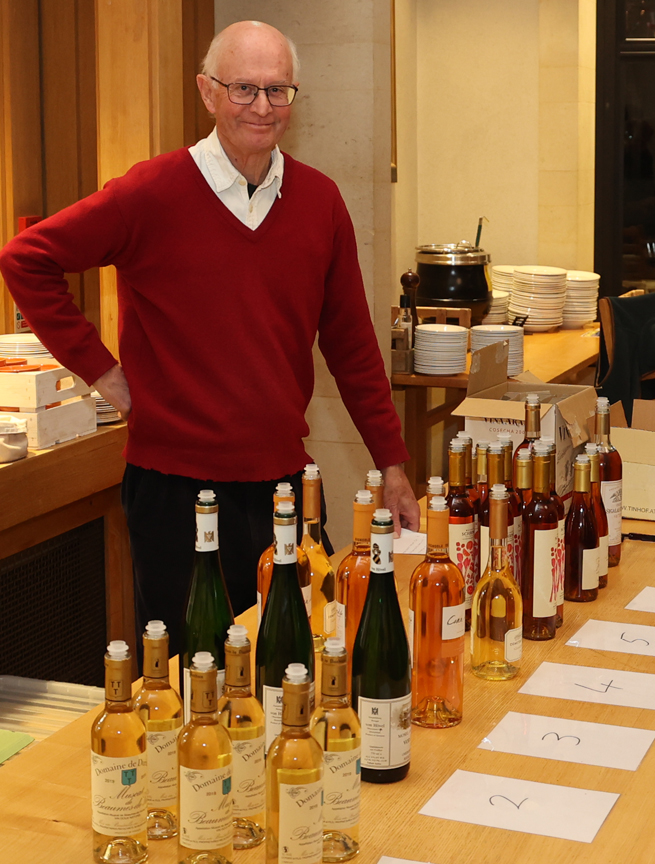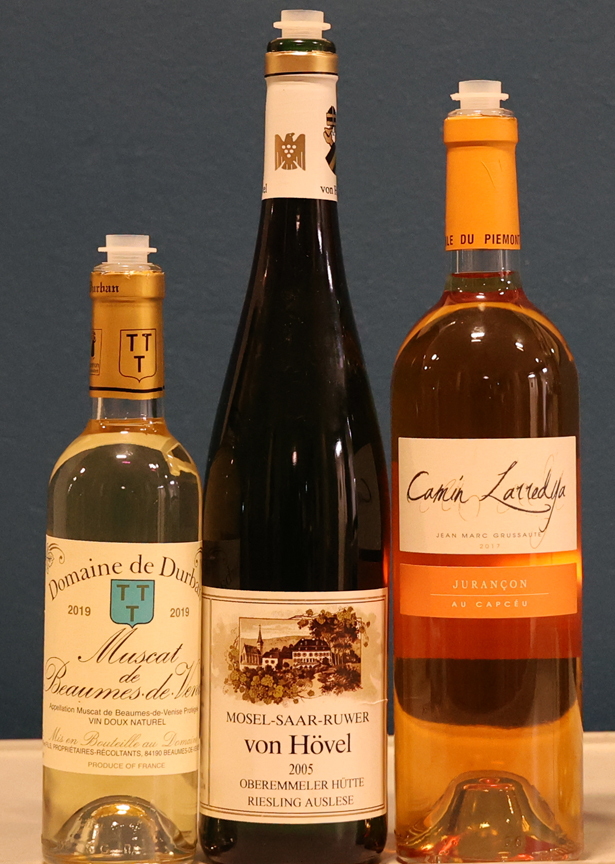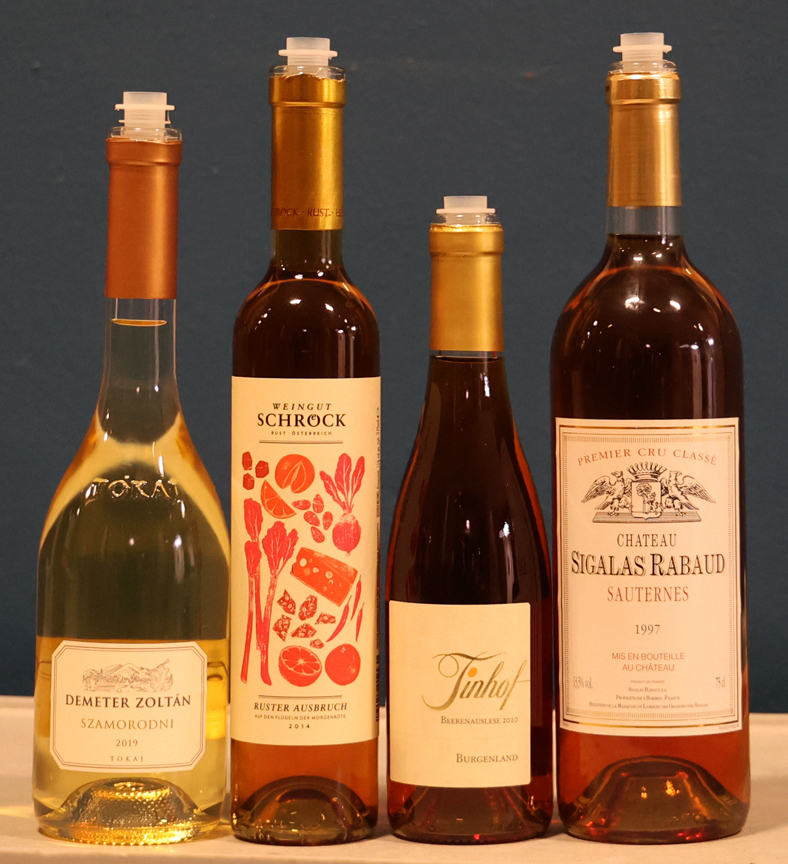 The word ‘selected’ considerably underplays Mark’s generosity when he presented seven spectacular sweet wines to the Club at St Cross on 22 November.
The word ‘selected’ considerably underplays Mark’s generosity when he presented seven spectacular sweet wines to the Club at St Cross on 22 November.
Many of those he showed were from his own – irreplaceable – library stock. Current prices for these wines – if they could be bought on the market – would have broken our bank by some distance.
For Mark, wines are under an imperative duty to be interesting. If they’re not, he’s not. In the case of sweet wines that means he’s always looking for good natural acidity so that the wines are not just ‘sweet’ but offer the possibility of refreshment. For our tasting he also wanted to show how these wines age. As he said, everyone knows what a young Sauternes tastes like – and he feels that in their middle years many sweet wines are uninteresting - but once they have thirty or forty years age? Well, we’ll come to that later…
The first wine of the evening was Leydier family’s 2019 Muscat de Beaumes de Venise from Domaine de Durban. In the 1970s, these muscats were cult wines. Popularised by Robin Yapp, they were hard to avoid at dinner parties up and down the land. Twenty hectares of the Leydiers’ 350m high 50 ha in Beaumes de Venise (Vacqueyras and Gigondas just next door) are devoted to muscat. They make red wine too – but this is hard to find in the UK and the appellation is rather overshadowed by its illustrious neighbours.
In the 1970s, these muscats were cult wines. Popularised by Robin Yapp, they were hard to avoid at dinner parties up and down the land. Twenty hectares of the Leydiers’ 350m high 50 ha in Beaumes de Venise (Vacqueyras and Gigondas just next door) are devoted to muscat. They make red wine too – but this is hard to find in the UK and the appellation is rather overshadowed by its illustrious neighbours.
Our wine, like all good muscats, was intensely aromatic with a bouquet of orange blossom and a touch of apricot. Adding grape spirit (the technique of ‘mutage’) stops the fermentation and leaves a wine with 90-100 grams of residual sugar and 15% alcohol. This was a young wine of course but it would age twenty years or more, gaining colour and intensity, if you left it undisturbed. Easy to say, but hard to do! Mark suggested that whilst it could serve as an aperitif or as a dessert wine, a French trick was to fill up the hole in a small cut melon. Add a bit of parma or Iberico ham and you’ve a wonderful starter for any dinner.
Wine no 2 was Weingut von Hovel’s 2005 Riesling Auslese from Oberemmeler Hutte. Like all but one of Mark’s fifty producers, this is a small family business. The one exception is a Benedictine monastery that’s been tending its property for a thousand years or so and ‘is not dictated to by their accountants’. Mark feels these families aren’t really in it to make money but for the satisfaction of doing a difficult job to the best of their ability. The Hutte vineyard in the Saar is a monopole owned by the Von Kunau family. One of Mark’s first tastings when he joined the legendary firm of OW Loeb & Co was of Von Kunau’s 1971 wine (‘one of the best German vintages of the last hundred years’) which showed him what great Riesling could be. That wine – if you find it and afford it – would still be in great shape. The high level of acidity means that Rieslings of this quality can easily age for fifty years. Although 13 years old, the wine we tasted is still young.
For Mark the recent German trend towards ‘trocken’ wines tends to flatten the distinctiveness of individual Riesling sites. It’s been made possible by climate change which allows full ripening of the Riesling grapes but, in his view, it also represents a shift away from the long-held German belief in wine for wine’s sake. For the French, wine is made to be paired with food; in Germany though a glass of Riesling mid-morning, or between tea and dinner, is (or perhaps was) perfectly natural.
Balance is one of Mark’s key criteria. That means looking not just at one element but considering acidity, sweetness, alcohol (and tannin of course) all together. Not all varieties achieve physiological ripeness at the same point. 12.5% can often be right for Cabernet whilst Merlot needs around 14.5%, ditto Grenache – at 12.5% the latter is simply too green, too herbaceous. And the 8% alcohol of the Hutte wine is in perfect balance with its 50 or so grams of sugar and high acidity.
There was perhaps a little bottle variation in colour, ranging from uniform gold in some glasses to the greenish tints of younger wine. On the nose there was very little of kerosene that some adore and some hate but lots of elegant lime and grapefruit and a touch of tangerine peel. Still lots of energy and lots of appeal – as there will be in another twenty or thirty years.
One of the strengths of this tasting was the sheer range of wines; the distinctiveness of each wine in this fabulous selection. For wine no 3 we were back in France (close to Pau in the Pyrenees) for a Jurançon Moelleux of 2017. Mark feels this is an area that ‘flies under the radar’. The Moelleux is produced on Camin Larredya by Jean-Marc Grussaute (once a rugby player, now a vigneron). This is the highest vineyard in the area at some 300-350 metres. He also makes an excellent dry wine from a Gros Manseng dominated blend but the Moelleux is 100% Petit Manseng which gives the wine huge intensity and attack. The colour is amber and the nose is a fascinating blend of orange peel and stone fruit with a touch of something close to roast banana (or was it Christmas pudding?). 14% alcohol with 90 grams RS and 6 grams of acid per litre. The wine making is slow: whole bunch pressing with wild yeasts and then 10 months of ageing on the lees in 225 litre barriques (mostly old). Jean-Marc makes on average 8000 bottles a year and though it’s not quite as slow a seller as the unpronounceable (to the average English consumer) Pacherenc du Vic Bilh it’s still a tricky sell. Your loss though…
 Tokay, by contrast, now recovered from its post-communist era slump, is well known and highly regarded. Under Russian domination the stress was on volume and the old heritage of the ‘greatest sweet wine’ in the world had been lost. But, with new investment (much of it from England in the early 1990s) the quality has been restored and wine no 4 was full proof of that assertion. Zoltan Demeter is a renowned Tokaji expert - consultant to others and producer of his own wine - has led the way in rediscovering the finest sites (and acquiring some of them!). His 2019 Szamorodni ‘Anett’ (his wife’s name) is clearly still very young but already sports a rich nose of ripe apple, apricots and lime with a touch of orange marmalade. The blend is dominated by Furmint and Harslevelu with a dash of Muskat Ottonel to add to the aromatics. 10% alcohol and RS of 212 grams though it wears it remarkably lightly thanks to the high acidity of the Furmint). Only around 174 cases of this wine are made each year. Not much botrytis here (to this reviewer’s palate) and, unlike the Aszú wines, it’s not a requirement of the appellation. This is a wine that will ‘age for as long as you like’.
Tokay, by contrast, now recovered from its post-communist era slump, is well known and highly regarded. Under Russian domination the stress was on volume and the old heritage of the ‘greatest sweet wine’ in the world had been lost. But, with new investment (much of it from England in the early 1990s) the quality has been restored and wine no 4 was full proof of that assertion. Zoltan Demeter is a renowned Tokaji expert - consultant to others and producer of his own wine - has led the way in rediscovering the finest sites (and acquiring some of them!). His 2019 Szamorodni ‘Anett’ (his wife’s name) is clearly still very young but already sports a rich nose of ripe apple, apricots and lime with a touch of orange marmalade. The blend is dominated by Furmint and Harslevelu with a dash of Muskat Ottonel to add to the aromatics. 10% alcohol and RS of 212 grams though it wears it remarkably lightly thanks to the high acidity of the Furmint). Only around 174 cases of this wine are made each year. Not much botrytis here (to this reviewer’s palate) and, unlike the Aszú wines, it’s not a requirement of the appellation. This is a wine that will ‘age for as long as you like’.
Szamorodni wines are also made dry, hence the name which means something like ‘as it comes’. Sweet szamorodni is not always as rich as the increasingly expensive Aszú wines which now cost more than Yquem and Mark explained that the old quality grading based on ‘puttonyos’ is now less and less used. The 3-4 puttonyos level is now rare though the 5-6 puttonyos level is still around. For Mark this was the most interesting wine of the tasting, but it should be noted that Demeter also makes highly regarded single varietal dry whites from his parcels of Furmint, Harslevelu and Muskat Ottonel. Well worth a taste if you’ve not tried them.
Wine no 5 was Heidi Schrock’s Ruster Ausbruch 2014, Auf den Flugeln der Morgenrote (‘on the wings of the dawn’). We had tasted a 2015 version of this wine a year or so back but that was 100% Welschriesling whereas this wine was a 50/50 blend of Weissburgunder and Welschriesling.
However, the Ruster Ausbruch is made from individually harvested botrytised berries (hence the term ‘ausbruch’ means ‘broken out’) – and undoubtedly contributing to the price of over £100 per half bottle. The grapes for this wine are grown on a number of parcels of land. The morning fog on the Neusiedlersee is the basis of the noble rot in the grapes and there was a strong note of caramelized orange marmalade in this nine-year-old wine. Older wines acquire a creme brûlée note - rather like Yquem - but this is not yet at that stage. Lots of sugar of course - perhaps 200-300 grams RS - and 11% alcohol but beautifully balanced, gratifyingly complex and with years of life and evolution to come. The producer also makes somewhat austere dry white wines and a red Blaufrankisch.
From Austria we headed to Germany and Erwin Tinhof’s 2010 Beerenauslese. Tinhof is based near Eisenstadt, just 45 minutes from Vienna. The producer has a new cellar and makes both red and white wines, as well as sweet wines when the conditions are right to do so, on his c12 hectare estate. The two wines (5 and 6) were similarly dark in colour. However, the Beerenauslese, which is made from Neuburger (a local Austrian grape) and Welschriesling, has more restrained botrytis. Slightly more alcohol at 12% and probably 180-200 grams RS - but, as ever with good Riesling, balanced and vital. Mark explained to us that the sugar and botrytis will mask the characteristics of the individual grape varieties. Despite its greater age, Mark thought it a touch less complex than the Ruster Ausbruch. Nonetheless a fine wine which will continue to age for 10-30 years.
The last wine of the evening was a 1997 Sauternes, the Château Sigalas Rabaud. A good vintage (especially for white wines) and a great wine. Mark had made it clear from the beginning of the tasting that he wanted to show us how sweet wines age and this Premier Cru Sauternes was both fascinating and fantastic. This would have been a Sauvignon / Semillon blend, probably with a touch of Muscadelle (perhaps 10% at most). Deep colour again and this wine really did have that apricots, burnt sugar and crème brûlée note of good, aged Sauternes. Perhaps as much as 14% alcohol but certainly 13%. Already over 25 years old - an example of Mark’s remarkable generosity given the current price of over £75 a bottle - but with many years of life yet to come. We were privileged…
In her vote of thanks, Hilary Reid Evans stressed not just Mark’s generosity and remarkable wines but also his ‘effortless knowledge’. Rightly so. A memorable tasting. She also went out of her way to thank those in the Club who had made this tasting - and so many others - so successful and we were happy to thank St Cross for their hospitality.
GH: 23/11/23